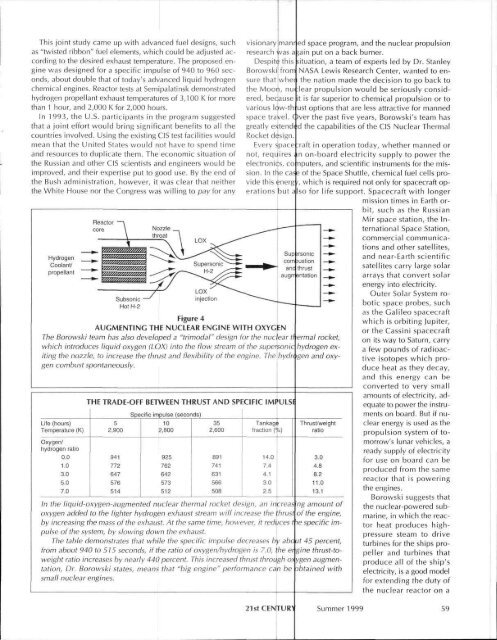Back to the Moon with Nuclear Rockets
Back to the Moon with Nuclear Rockets
Back to the Moon with Nuclear Rockets
- No tags were found...
Create successful ePaper yourself
Turn your PDF publications into a flip-book with our unique Google optimized e-Paper software.
This joint study came up <strong>with</strong> advanced fuel designs, suchas "twisted ribbon" fuel elements, which could be adjusted according<strong>to</strong> <strong>the</strong> desired exhaust temperature. The proposed enginewas designed for a specific impulse of 940 <strong>to</strong> 960 seconds,about double that of <strong>to</strong>day's advanced liquid hydrogenchemical engines. Reac<strong>to</strong>r tests at Semipalatinsk demonstratedhydrogen propellant exhaust temperatures of 3,100 K for morethan 1 hour, and 2,000 K for 2,000 hours.In 1993, <strong>the</strong> U.S. participants in <strong>the</strong> program suggestedthat a joint effort would bring significant benefits <strong>to</strong> all <strong>the</strong>countries involved. Using <strong>the</strong> existing CIS test facilities wouldmean that <strong>the</strong> United States would not have <strong>to</strong> spend timeand resources <strong>to</strong> duplicate <strong>the</strong>m. The economic situation of<strong>the</strong> Russian and o<strong>the</strong>r CIS scientists and engineers would beimproved, and <strong>the</strong>ir expertise put <strong>to</strong> good use. By <strong>the</strong> end of<strong>the</strong> Bush administration, however, it was clear that nei<strong>the</strong>r<strong>the</strong> White House nor <strong>the</strong> Congress was willing <strong>to</strong> pay for anyFigure 4AUGMENTING THE NUCLEAR ENGINE WITH OXYGENThe Borowski team has also developed a "trimodal" design for <strong>the</strong> nuclear tl ermal rocket,which introduces liquid oxygen (LOX) in<strong>to</strong> <strong>the</strong> flow stream of <strong>the</strong> supersonic hydrogen exiting<strong>the</strong> nozzle, <strong>to</strong> increase <strong>the</strong> thrust and flexibility of <strong>the</strong> engine. The hydn >gen and oxygencombust spontaneously.In <strong>the</strong> liquid-oxygen-augmented nuclear <strong>the</strong>rmal rocket design, an increas ng amount ofoxygen added <strong>to</strong> <strong>the</strong> lighter hydrogen exhaust stream will increase <strong>the</strong> thrust of <strong>the</strong> engine,by increasing <strong>the</strong> mass of <strong>the</strong> exhaust. At <strong>the</strong> same time, however, it reduces t le specific impulseof <strong>the</strong> system, by slowing down <strong>the</strong> exhaust.The table demonstrates that while <strong>the</strong> specific impulse decreases by abc uf 45 percent,from about 940 <strong>to</strong> 515 seconds, if <strong>the</strong> ratio of oxygen/hydrogen is 7.0, <strong>the</strong> er gine thrust-<strong>to</strong>weightratio increases by nearly 440 percent. This increased thrust through o> ygen augmentation,Dr. Borowski states, means that "big engine" performance can be obtained <strong>with</strong>small nuclear engines.visionary manr ed space program, and <strong>the</strong> nuclear propulsionresearch was a >ain put on a back burner.Despite this situation, a team of experts led by Dr. StanleyBorowski from NASA Lewis Research Center, wanted <strong>to</strong> ensurethat whei <strong>the</strong> nation made <strong>the</strong> decision <strong>to</strong> go back <strong>to</strong><strong>the</strong> <strong>Moon</strong>, nuclear propulsion would be seriously considered,because it is far superior <strong>to</strong> chemical propulsion or <strong>to</strong>various low-th ust options that are less attractive for mannedspace travel. Over <strong>the</strong> past five years, Borowski's team hasgreatly extendi d <strong>the</strong> capabilities of <strong>the</strong> CIS <strong>Nuclear</strong> ThermalRocket design.Every space ;raft in operation <strong>to</strong>day, whe<strong>the</strong>r manned ornot, requires .in on-board electricity supply <strong>to</strong> power <strong>the</strong>electronics, co nputers, and scientific instruments for <strong>the</strong> mission.In <strong>the</strong> ca< 2 of <strong>the</strong> Space Shuttle, chemical fuel cells providethis energ r, which is required not only for spacecraft operationsbut also for life support. Spacecraft <strong>with</strong> longermission times in Earth orbit,such as <strong>the</strong> RussianMir space station, <strong>the</strong> InternationalSpace Station,commercial communicationsand o<strong>the</strong>r satellites,and near-Earth scientificsatellites carry large solararrays that convert solarenergy in<strong>to</strong> electricity.Outer Solar System roboticspace probes, suchas <strong>the</strong> Galileo spacecraftwhich is orbiting Jupiter,or <strong>the</strong> Cassini spacecraf<strong>to</strong>n its way <strong>to</strong> Saturn, carrya few pounds of radioactiveiso<strong>to</strong>pes which produceheat as <strong>the</strong>y decay,and this energy can beconverted <strong>to</strong> very smallamounts of electricity, adequate<strong>to</strong> power <strong>the</strong> instrumentson board. But if nuclearenergy is used as <strong>the</strong>propulsion system of <strong>to</strong>morrow'slunar vehicles, aready supply of electricityfor use on board can beproduced from <strong>the</strong> samereac<strong>to</strong>r that is powering<strong>the</strong> engines.Borowski suggests that<strong>the</strong> nuclear-powered submarine,in which <strong>the</strong> reac<strong>to</strong>rheat produces highpressuresteam <strong>to</strong> driveturbines for <strong>the</strong> ships propellerand turbines thatproduce all of <strong>the</strong> ship'selectricity, is a good modelfor extending <strong>the</strong> duty of<strong>the</strong> nuclear reac<strong>to</strong>r on a21stCENTUR> Summer 1999 59
















